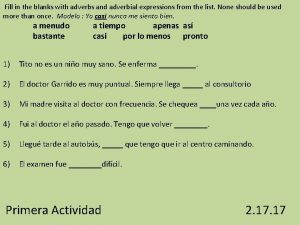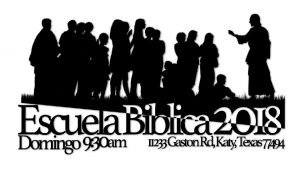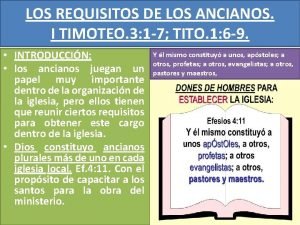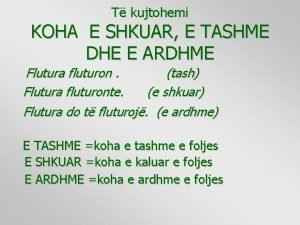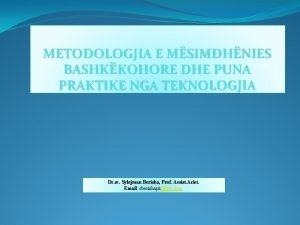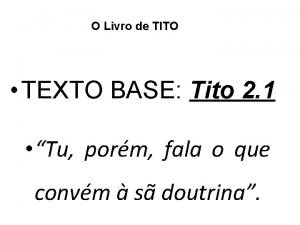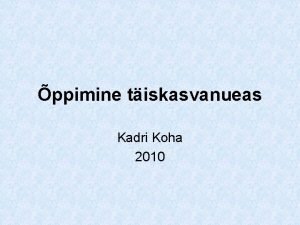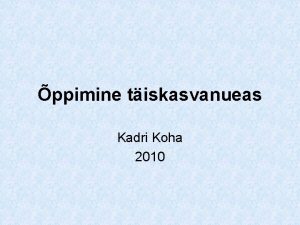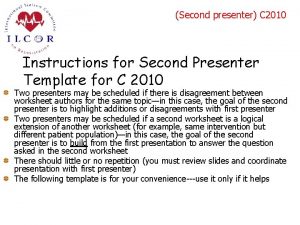Koha Conference 2010 Gretsa University Presenter Tito Wawire
































- Slides: 32

Koha Conference 2010 Gretsa University Presenter: Tito Wawire US Embassy, Library of Congress

Understanding MARC 21 MARC is an acronym, used in the field of library science, that stands for MAchine-Readable Cataloging

The Library of Congress serves as the official depository of United States publications and is a primary source of cataloging records for US and international publications. When the Library of Congress began to use computers in the 1960 s, it devised the LC MARC format, a system of using brief numbers, letters, and symbols within the cataloging record itself to mark different types of information. The original LC MARC format evolved into MARC 21 and has become the standard used by most library computer programs. The MARC 21 bibliographic format, as well as all official MARC 21 documentation, is maintained by the Library of Congress. It is published as MARC 21 Format for Bibliographic Data.

Agency-assigned Data Elements An agency-assigned data element is one whose content is determined by a designated agency and is the responsibility of that agency, e. g. , field 021 which is the responsibility of an ISSN Center. While it is usually input by the designated agency, it may be transcribed by another organization. Another example is the LCCN- Library of Congress Control Number which is the responsibility of the Library of Congress Agency.

MARC standards The MARC standards consist of the MARC formats, which are standards for the representation and communication of bibliographic and related information in machine-readable form, and related documentation. It provides the protocol by which computers exchange, use, and interprets bibliographic information.

MARC Record Elements A MARC record is composed of three elements: …. the record structure …. the content designation …. the data content of the record

Record Structure The record structure is an implementation of the international standard Format for Information Exchange

Content Designation The content designation--the codes and conventions established explicitly to identify and further characterize the data elements within a record and to support the manipulation of that data--is defined by each of the MARC formats.

content of the data elements The content of the data elements that comprise a MARC record is usually defined by standards outside the formats. Examples are the International Standard Bibliographic Description (ISBD), Anglo-American Cataloguing Rules, Library of Congress Subject Headings (LCSH), or other cataloging rules, subject thesauri, and classification schedules

MARC 21 types of data: MARC 21 has formats for the following five types of data: v. Bibliographic Format v. Authority Format v Holdings Format v. Community Format v. Classification Data Format.

COMPONENTS OF BIBLIOGRAPHIC RECORDS Leader - Data elements that primarily provide information for the processing of the record. The data elements contain numbers or coded values identified by relative character position. The Leader is fixed in length at 24 character positions and is the first field of a MARC record. Directory - A series of entries that contain the tag, length, and starting location of each variable field within a record. Each entry is 12 character positions in length. Variable fields - The data in a MARC bibliographic record is organized into variable fields, each identified by a threecharacter numeric tag that is stored in the Directory entry for the field. Each field ends with a field terminator character. There are two types of variable fields: Variable control fields - Variable data fields.

content designation Indicator positions - The first two character positions in the variable data fields that contain values which interpret or supplement the data found in the field. Indicator values are interpreted independently, that is, meaning is not ascribed to the two indicators taken together. Indicator values may be a lowercase alphabetic or a numeric character. Subfield codes - Two characters that distinguish the data elements within a field which require separate manipulation. A subfield code consists of a delimiter (ASCII 1 F hex), represented in this document as a $, followed by a data element identifier. Data element identifiers may be a lowercase alphabetic or a numeric character.

Field and Subfield Repeatability Theoretically, all fields and subfields may be repeated. The nature of the data, however, often precludes repetition. For example, a bibliographic record may contain more than one 650 main entry field depending on the number of topical terms identified in a piece of work.

Record Content Responsibility The responsibility for the data content, content designation, and transcription of bibliographic information within a record may be determined by examination of the field indicated in the responsible parties. The data content of certain data elements, however, is restricted when the element is an agency -assigned or a controlled-list data element.

Responsible Parties In unmodified records, the organization identified as the original cataloging source in 008/39 and/or 040 is responsible for the content of the record. The organization identified as the transcribing agency in field 040 is responsible for the content designation and transcription of the data. In modified records, the organizations identified in 040 and subfield $d (Modifying agency) are collectively responsible for the content of the record. Organizations identified as transcribing or modifying agencies in field 040 $c and $d are collectively responsible for the content designation and transcription of the data.

Controlled-list Data Elements Certain data elements contain data from controlled lists maintained by designated agencies, e. g. , the MARC Code List for Geographic Areas in field 043 (Geographic Area Code), the MARC Code List for Languages in field 041. These elements are indicated at the field or subfield level in MARC 21 and only values from the designated lists may be used. If a change or addition is desirable for a list, the maintenance agency for the list should be consulted.

Record Level Requirements User groups may have full level and minimal level record requirements to promote consistency across cataloging agencies. These should be widely publicized for all possible interchange partners to be aware. MARC Bibliographic Frameworks Allows you to create custom frameworks for cataloging. Users are able to Choose 'MARC structure' they wish to edit or build.

FIELDS are marked by TAGS A field: Each bibliographic record is divided logically into fields. There is a field for the author, a field for title information, and so on. These fields are subdivided into one or more "subfields. " As previously noted, the textual names of the fields are too lengthy to be reproduced within each MARC record. Instead they are represented by 3 -digit tags.

tag A tag: Each field is associated with a 3 -digit number called a "tag. " A tag identifies the field -- the kind of data -- that follows. Even though a printout or screen display may show the tag immediately followed by indicators (making it appear to be a 4 or 5 -digit number), the tag is always the first 3 digits.

010 tag marks the Library of Congress Control Number (LCCN) 020 tag marks the International Standard Book Number (ISBN) 100 tag marks a personal name main entry (author) marks the title information (which includes the title, other title information, and the statement of responsibility) 250 tag marks the edition 260 tag marks the publication information marks the physical description (often referred to as the "collation" when describing books) 490 tag marks the series statement 520 tag marks the annotation or summary note 650 tag marks a topical subject heading 245 tag 300 tag 700 tag marks a personal name added entry (joint author, editor, or illustrator) Here is an example of a field. The number 100 is the tag, defining it as a personal name main entry (author) field. 100 1# $a Achebe, Chinua.

SUBFIELDS are marked by SUBFIELD CODES and DELIMITERS A subfield: Most fields contain several related pieces of data. Each type of data within the field is called a subfield, and each subfield is preceded by a subfield code. Fields 001 through 009 have no subfields. For example, the field for a book's physical description (defined by the tag 300) includes a subfield for the extent (number of pages), a subfield for other physical details (illustration information), and a subfield for dimensions (centimeters): 300 ## $a 675 p. : $b ill. ; $c 24 cm.

Subfield code: A subfield code: Subfield codes are one lowercase letter (occasionally a number) preceded by a delimiter. A delimiter is a character used to separate subfields. Each subfield code indicates what type of data follows it. (For each field in the MARC 21 bibliographic format, the MARC 21 documentation lists and describes the valid subfield codes. )

Delimiter: A delimiter: Different software programs use different characters to represent the delimiter on the screen or on printouts. Examples are a double dagger ( ), an "at sign" (@), a dollar sign ($), an underline ( _ ), or the graphic symbol " ". In this publication the dollar sign ($) is used as the delimiter portion of the subfield code. In the example above, the subfield codes are $a for the extent, $b for other physical details, and $c for dimensions.

Content Designators … is an inclusive term used to refer to tags, indicators, and subfield codes. The three kinds of content designators -- tags, indicators, and subfield codes -- are the keys to the MARC 21 notation system.

Indicators: Two character positions follow each tag (with the exception of Fields 001 through 009). One or both of these character positions may be used for indicators. In some fields, only the first or second position is used; in some fields, both are used; and in some fields, like the 020 and 300 fields, neither is used. When an indicator position is not used, that indicator is referred to as "undefined" and the position is left blank. It is the convention to represent a blank, or undefined, indicator position by the character "#".

Cont… Each indicator value is a number from 0 to 9. (Although the rules say it can be a letter, letters are uncommon. ) Even though two indicators together may look like a 2 -digit number, they really are two single-digit numbers. The allowable indicator values and their meanings are spelled out in the MARC 21 documentation. In the example which follows, the first 3 digits are the tag (245 defines this as a title field) and the next 2 digits (a 1 and a 4) are indicator values. The 1 is the first indicator; 4 is the second indicator.

Example… 245 14 $a The emperor's new clothes / $c adapted from Hans Christian Andersen and illustrated by Janet Stevens

First indicator A first indicator value of 1 in the title field indicates that there should be a separate title entry in the catalog. In the card catalog environment, this means that a title card should be printed for this item and an entry for "Title" added to the tracings. A first indicator value of 0 would mean that a title main entry is involved; the card would be printed with the traditional hanging indention, and no additional tracing for the title would be required (since it is the main entry).

Nonfiling characters: One of the more interesting indicators is the second indicator for the title field. It displays the number of characters at the beginning of the field (including spaces) to be disregarded by the computer in the sorting and filing process. For the title The emperor's new clothes, the second indicator is set to "4" so that the first four characters (the "T, " the "h, " the "e, " and the space) will be skipped and the title will be filed under "emperor's. "

General principles Access points: Access points (a main entry, subject added entries, and other added entries) are an important part of the bibliographic record. These are the headings for which separate cards were created for the traditional card catalog, and which a patron or librarian can search in an online catalog. Most of the access points are in:

Most of the access points are in: 1 XX fields (main entries) 4 XX fields (series statements) 6 XX fields (subject headings) 7 XX fields (added entries other than subject or series) 8 XX fields (series added entries) These are the fields that are under authority control. "Authority control" means following a recognized or established form.

Why one standard? MARC standard prevents duplication of work and allows libraries to better share bibliographic resources. MARC enables libraries to acquire cataloging data that is predictable and reliable. MARC standard also enables libraries to make use of commercially available library automation systems to manage library operations. MARC standard also allows libraries to replace one system with another with the assurance that their data will still be compatible.
 Customer experience management conference 2010
Customer experience management conference 2010 Tito and bimbo
Tito and bimbo Loana tito nogueira
Loana tito nogueira Tito le clown
Tito le clown Estudo sobre o livro de tito
Estudo sobre o livro de tito Tito boeri biografia
Tito boeri biografia Senatvs popvlvsqve romanvs
Senatvs popvlvsqve romanvs Me enfermaba con frecuencia. 2. íbamos a la playa.
Me enfermaba con frecuencia. 2. íbamos a la playa. Loana tito nogueira
Loana tito nogueira Es un tito perezoso chico in english
Es un tito perezoso chico in english Proemio discorsi sopra la prima deca di tito livio
Proemio discorsi sopra la prima deca di tito livio Sermo cotidianus plauto
Sermo cotidianus plauto Tito capítulo 2
Tito capítulo 2 Tito patea la pelota
Tito patea la pelota Torna-te pessoalmente padrão de boas obras
Torna-te pessoalmente padrão de boas obras Llaman tito 2
Llaman tito 2 Carta a tito capitulo 2
Carta a tito capitulo 2 Tito pranolo
Tito pranolo Tito livio vita e opere
Tito livio vita e opere Ancianos
Ancianos Errais por não conhecer as escrituras
Errais por não conhecer as escrituras Tito latif indra
Tito latif indra Josip broz tito biografia
Josip broz tito biografia Steve jobs commencement address
Steve jobs commencement address Kohet e foljes jam
Kohet e foljes jam Koha vs evergreen
Koha vs evergreen Aktivitetet e kohes se lire
Aktivitetet e kohes se lire Koha open source software free download
Koha open source software free download Koha ditore
Koha ditore 5 vargesh
5 vargesh Opals library software
Opals library software Liblime koha demo
Liblime koha demo Text presenter
Text presenter







